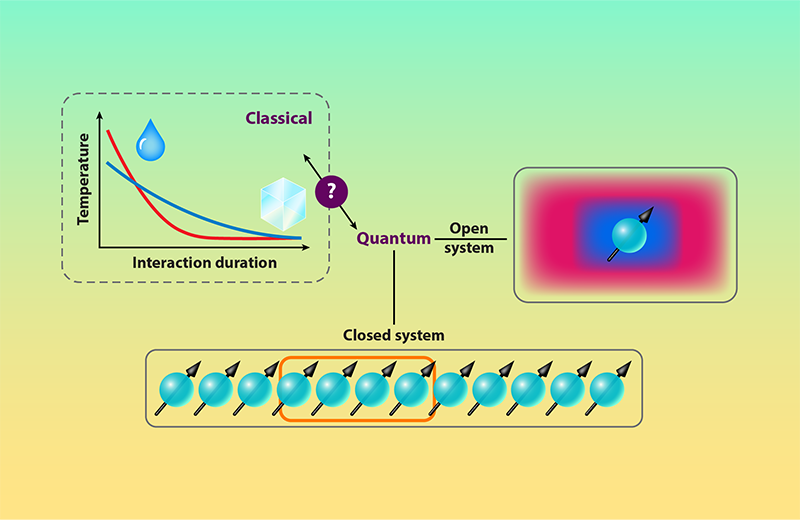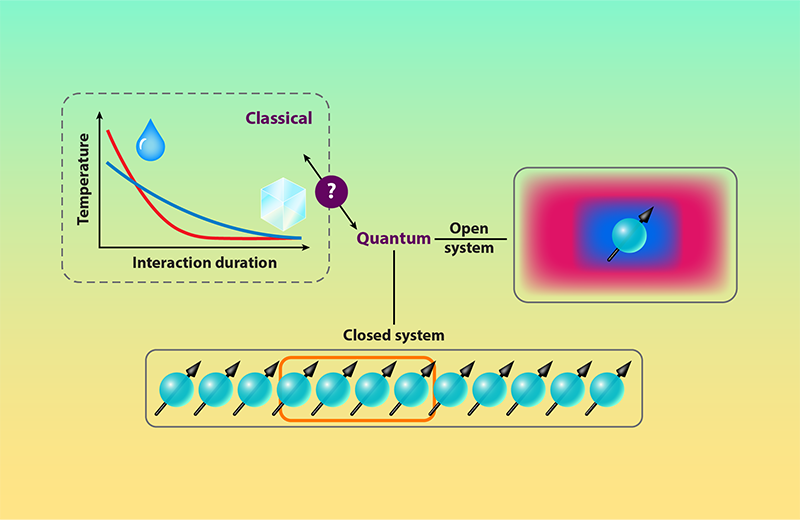Exploring Quantum Mpemba Effects
Under certain conditions, warm water can freeze faster than cold water. This phenomenon was named the Mpemba effect after Erasto Mpemba, a Tanzanian high schooler who described the effect in the 1960s [1]. The phenomenon has sparked intense debates for more than two millennia and continues to do so [2]. Similar processes, in which a system relaxes to equilibrium more quickly if it is initially further away from equilibrium, are being intensely explored in the microscopic world. Now three research teams provide distinct perspectives on quantum versions of Mpemba-like effects, emphasizing the impact of strong interparticle correlations, minuscule quantum fluctuations, and initial conditions on these relaxation processes [3–5]. The teams’ findings advance quantum thermodynamics and have potential implications for technologies, ranging from information processors to engines, powered by quantum resources.
In top-down strategies, physicists use observations of macroscopic (classical) phenomena to infer fundamental microscopic (quantum) processes; in bottom-up strategies, they use studies of those fundamental processes to predict classical phenomena. Historically, studies of the Mpemba effect began with empirical observations and ad hoc assumptions about the microscopic world. Despite descriptions of the effect by Aristotle and Descartes, and modern attention from Mpemba, the phenomenon has not influenced the field of thermodynamics. The Mpemba effect is complex, lacks a precise definition, and has reproducibility issues. As a result, experimental observations and explanations have been debated for decades without consensus, making the effect often seem like just a curiosity.
To study the Mpemba effect and other relaxation processes, physicists define a figure of merit, such as temperature, for the system of interest and record it as a function of the duration over which the system interacts with an external environment (Fig. 1). This relationship quantifies how quickly the system goes from an initial state to a steady state, determining whether the faster of two paths to equilibrium is the one that begins further away from equilibrium. A few years ago, researchers made great strides by observing that a colloidal system can cool exponentially faster if it starts at a higher temperature, in alignment with specific theoretical models [6]. This work strengthened the top-down strategy, leading these scientists to conclude that the Mpemba effect is not merely a curiosity but an archetype for a wide range of anomalous relaxation phenomena.
These remarks spurred further explorations and led, in the past few years, to two bottom-up approaches for studying quantum versions of Mpemba-like effects, with corresponding theoretical predictions built on the framework of quantum nonequilibrium dynamics. The first and most fundamental bottom-up approach takes account of the full unitary (that is, reversible) dynamics of closed many-body systems. Here, thermodynamic properties are predicted to emerge when measuring subsystem observables because of quantum fluctuations and entanglement between subsystems. In this context, at zero temperature, an anomalous relaxation process can occur in which greater initial symmetry breaking of a subsystem leads to faster symmetry restoration. The degree of symmetry breaking can be expressed by a quantity called the entanglement asymmetry [7].
The second bottom-up approach avoids the complexity of many-body descriptions by capturing effective subsystem dynamics. Here, the entire system is subdivided into an open system of interest and a specific environment, which interact with each other. For non-Markovian dynamics (those that depend on a system’s history), entanglement manifests as memory effects, in which the history of the entire system influences the dynamical behavior of the open system. These conditions provide fertile ground for the emergence of quantum Mpemba-like effects. But even in the case of Markovian dynamics, in which these memory effects are absent, it is predicted that the initial conditions of the open system have a crucial impact on relaxation processes and that quantum Mpemba-like effects might be seen [8, 9].
How can scientists collect empirical evidence for such quantum behavior? Key technical advances began in the 1950s with the development of high-precision atomic clocks, leading to the emergence of the trapped-ion platform. This platform sets the stage for the observation of fundamental processes by suspending individual ions in ultrahigh-vacuum chambers to reduce disturbances. Engineered communication channels in this platform enable state preparation, manipulation, and readout. Today, various other experimental platforms, such as superconducting qubits, quantum dots, and ultracold atoms, are used to study quantum dynamics and compare them to theoretical predictions. Consequently, ideal testing grounds for investigating quantum Mpemba-like effects were at hand for the three new studies.
Shahaf Aharony Shapira and colleagues at the Weizmann Institute of Science in Israel used the open-system approach and performed experiments on a single trapped ion, whose cold spin was coupled to a warm Markovian environment in thermal equilibrium [3]. This relatively simple arrangement is particularly effective for displaying fundamental physics relevant to information processing. The researchers showed that the ion’s spin reached thermal equilibrium with the environment faster when the spin started at a lower temperature, a type of inverse quantum Mpemba-like effect.
By contrast, Lata Joshi at the Austrian Academy of Sciences and colleagues adopted the unitary approach and experimentally studied a closed quantum system consisting of a chain of 12 interacting trapped ions near zero temperature [4]. By considering particular subsystems, the researchers showed that the spins of the ions restored their symmetry more rapidly when they were initially further away from their symmetric state, another type of quantum Mpemba-like effect. This investigation relied on randomized measurements and sophisticated data-selection techniques. It also built on the aforementioned entanglement-asymmetry measure [7] and used a further measure to offer more-direct evidence of subsystem equilibration. This work thereby stresses the intricate interplay between entanglement, quantum fluctuations, and equilibration.
Lastly, Colin Rylands at the International School for Advanced Studies (SISSA) in Italy and colleagues theoretically studied the microscopic mechanisms driving quantum Mpemba-like effects, showing how anomalous relaxation processes emerge in closed quantum systems [5]. By examining the impact of quantum fluctuations on these processes in representative cases, the researchers offer insights into the principles governing quantum Mpemba-like effects. This analysis bridges the gap between experimental observations and theoretical predictions, contributes a basis for an intuitive understanding of these phenomena, and complements other work [4, 7].
Overall, these three studies provide intriguing perspectives on quantum thermodynamics and relaxation processes. As this research area progresses, scientists will hopefully find equivalences between the open-system and unitary approaches. More work on various quantum platforms is expected soon, aiming to further refine our understanding of the interplay of entanglement, quantum fluctuations, memory effects, initial states, subsystem choices, and equilibration. Such work could set up a rigorous framework for quantum thermodynamics and inspire innovative technologies in areas ranging from computing to energy storage. But when will physicists better understand how fundamental processes affect the cooling of warm water in a fridge?
References
- E. B. Mpemba and D. G. Osborne, “Cool?” Phys. Educ. 4, 172 (1969).
- M. Jeng, “The Mpemba effect: When can hot water freeze faster than cold?” Am. J. Phys. 74, 514 (2006).
- S. Aharony Shapira et al., “Inverse Mpemba effect demonstrated on a single trapped ion qubit,” Phys. Rev. Lett. 133, 010403 (2024).
- L. Kh. Joshi et al., “Observing the quantum Mpemba effect in quantum simulations,” Phys. Rev. Lett. 133, 010402 (2024).
- C. Rylands et al., “Microscopic origin of the quantum Mpemba effect in integrable systems,” Phys. Rev. Lett. 133, 010401 (2024).
- A. Kumar and J. Bechhoefer, “Exponentially faster cooling in a colloidal system,” Nature 584, 64 (2020).
- F. Ares et al., “Entanglement asymmetry as a probe of symmetry breaking,” Nat. Commun. 14, 2036 (2023).
- F. Carollo et al., “Exponentially accelerated approach to stationarity in Markovian open quantum systems through the Mpemba effect,” Phys. Rev. Lett. 127, 060401 (2021).
- A. K. Chatterjee et al., “Quantum Mpemba effect in a quantum dot with reservoirs,” Phys. Rev. Lett. 131, 080402 (2023).





